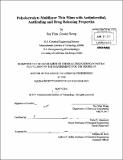Polyelectrolyte multilayer thin films with antimicrobial, antifouling and drug releasing properties
Author(s)
Wong, Sze Yinn (Sze Yinn Jessie)
DownloadFull printable version (15.76Mb)
Other Contributors
Massachusetts Institute of Technology. Dept. of Chemical Engineering.
Advisor
Paula T. Hammond.
Terms of use
Metadata
Show full item recordAbstract
This thesis work focuses on designing thin polyelectrolyte multilayer (PEM) films via layer-bylayer (LbL) deposition technique with the ability to kill pathogenic bacteria and inactivate human viruses, especially the influenza (flu) virus on contact. This work builds on four years of research at the Institute for Soldier Nanotechnologies (ISN) focusing on creating new, nonleaching microbicidal material; this film is envisioned to be used as permanent surface coatings for weapons, equipments, uniforms, personal items, etc. because a small reduction in the rate of infection will greatly enhance the readiness and performance of soldiers and other military personnel. Extending this application to everyday life, commonly handled objects such as doorknobs, computer keyboards, and touch screens can also be made sterile by coating them with these highly effective microbicidal PEM films. These films can also be used to prevent infections and long-term bacterial biofilms on implant surfaces. The ultimate aim of this thesis work is to create a broadly applicable multifunctional platform film technology that will satisfy various thin film surface coating applications; this film will impart a surface with long term antimicrobial / antifouling functionality via a permanent microbicidal base, and controlled delivery of a therapeutic agent via a hydrolytically degradable top film as needed. Efforts were focused on maximizing and understanding the factors that influence the microbicidal / antifouling property of the film; thus far, we successfully designed a set of contact-killing ionically cross-linked polymeric thin films; a hydrophobic polycation, linear NNdodecyl, methyl- poly(ethylenimine) (DMLPEI) with microbicidal activity was layered with a hydrophilic polyanion, such as poly(acrylic acid) (PAA), to create LbL films highly effective against Escherichia coli and Staphylococcus aureus (Gram negative and positive bacteria, respectively), as well as the influenza A/WSN (H1N1) virus. The microbicidal film was also demonstrated to significantly resist adsorption of protein from blood plasma relative to an uncoated substrate. By generating PEM films assembled with the hydrophobic N-alkylated poly(ethylenimine) and the hydrophilic poly(acrylic acid), an ultrathin film that exhibited antifouling and antimicrobial properties was created. Results showed that a fine balance of hydrophobicity and hydrophilicity on the surface of the films was needed to create molecularlevel heterogeneities unfavorable to protein adsorption; due to the contrasting nature of the polymer making up the film, nanoscale segregation of the polymer segments into hydrophobic and hydrophilic moieties could occur on the surface. We then moved on to design a dual functional LbL film construct combining the permanent microbicidal / antifouling base film with a hydrolytically degradable PEM top film offering controlled and localized delivery of therapeutics (e.g. antibiotic, anti-inflammatory drug, etc.). When the degradable top film is completely eroded, the surface will be left with the permanent microbicidal film for long-term prevention of fouling by biomolecules and microorganisms (e.g., proteins and bacteria).
Description
Thesis (Ph. D.)--Massachusetts Institute of Technology, Dept. of Chemical Engineering, 2011. Cataloged from PDF version of thesis. Includes bibliographical references (p. 152-160).
Date issued
2011Department
Massachusetts Institute of Technology. Department of Chemical EngineeringPublisher
Massachusetts Institute of Technology
Keywords
Chemical Engineering.